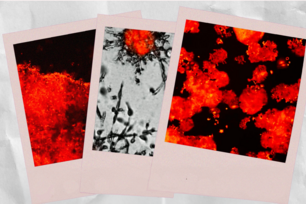
Whitehead Institute researchers have developed a methodology to monitor changes in DNA methylation over time in individual cells. In these microscope images, mouse induced pluripotent stem cells (iPSCs, left image) were analyzed for unique pluripotency markers. Previously, researchers used conventional GFP reporter that glowed green when a stem cell specific gene was being expressed (e.g., Nanog, right image). In the center image, Whitehead scientists used the new system to highlight hypomethylation events in certain super enhancers, (e.g., Sox2) that are unique to pluripotent stem cells (red).
Courtesy of Cell Press.
New methodology tracks changes in DNA methylation in real time at single-cell resolution
CAMBRIDGE, Mass. – Whitehead Institute researchers have developed a methodology to monitor changes in DNA methylation over time in individual cells.
DNA methylation is essential for the proper control of gene expression and cell identity—what enables cells with the same genetic material to become, for example, a nerve cell, a muscle cell or a skin cell. Certain diseases, including cancer, involves changes in DNA methylation patterns, and the ability to document these alterations aid in the development of novel therapies.
“Methylation is really key in development, in disease, and in cancer,” says Whitehead Founding Member Rudolf Jaenisch, who is also a professor of biology at MIT. “This reporter is a very important tool. We believe it will allow us to look in a very detailed way at issues like imprinting during development and screening for the activation of genes silenced in diseases like cancer. This method will allow us to see which drug will activate a given gene.”
An individual’s cells rely on the same set of genes as instructions for protein production. The differences between a muscle cell and a brain cell are attributable to differences in gene expression; that is, which genes are turned on and off. DNA methylation—the addition of methyl groups to the DNA—is an epigenetic mechanism that controls gene expression. In most cases, methylated genes are switched off, while unmethylated genes are active.
To date, scientists have only been able to study methylation in a population of cells by taking a “snapshot” of a few cells, a process that destroys the very cells under study. Because most cell populations in vivo are heterogeneous, and methylation can change over time, existing approaches have offered limited insight into this fundamental biological control.
Creating a system that dynamically visualizes methylation at the level of a single cell intrigued Yonatan Stelzer, a postdoctoral researcher in Jaenisch’s lab. Working with graduate student Chikdu Shivalila, Stelzer synthesized a DNA methylation reporter that mirrors whether a nearby region is methylated. When the target region is unmethylated, the reporter is also unmethylated, which allows expression of a glowing protein encoded by the reporter. This protein illuminates the cell. When the target is methylated, so too is the reporter, and the glowing protein remains unexpressed, leaving the cell unlit. As the target region’s methylation changes, so does the reporter’s.
Stelzer and Shivalila describe their work in this week’s issue of the journal Cell.
“Pharmaceutical companies have been interested in manipulating methylation in disease,” says Stelzer. “Now that we have a reporter for methylation, they can screen for small molecules or genes that can change a cell’s phenotype. For example, they could look for a drug that could change the hypermethylation that has been associated with a specific cancer.”
Using the method, scientists should learn much more about methylation itself.
“This opens up a whole new field of research,” says Shivalila. “You can use it to answer all of these questions about methylation that are completely unknown, including how methylation regulates gene transcription and expression patterns in cells. It’s very exciting.”
This work was supported by the National Institutes of Health (NIH grant HD 045022) and the Human Frontier Science Program. Rudolf Jaenisch is co-founder of Fate Therapeutics and an adviser to Stemgent.
* * *
Rudolf Jaenisch's primary affiliation is with Whitehead Institute for Biomedical Research, where his laboratory is located and all his research is conducted. He is also a professor of biology at Massachusetts Institute of Technology.
* * *
Full Citation:
Stelzer, Y. et al. “Tracing dynamic changes of DNA methylation at single cell resolution." Cell, September 24, 2015.
Contact
Communications and Public Affairs
Phone: 617-452-4630
Email: newsroom@wi.mit.edu


